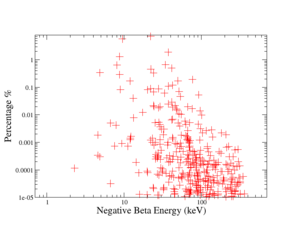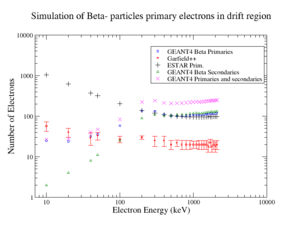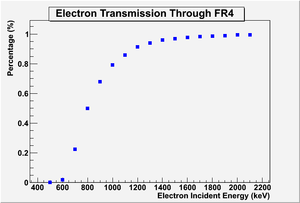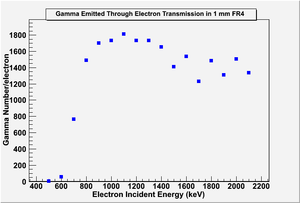Difference between revisions of "Beta Transmission and Ionization"
| Line 3: | Line 3: | ||
| − | [[File: beta_energy_percentages.png | 300 px] | + | [[File: beta_energy_percentages.png | 300 px]] |
| + | A simulation for beta ionization is performed using G4.9.6-p02, example TestEm10 helped in evaluating the number of primary and the secondary electrons in the drift region. | ||
| − | + | [[File: G4_1cmAr90CO2_Beta_primaryElecN.png| 300 px]][http://articles.adsabs.harvard.edu/cgi-bin/nph-iarticle_query?bibcode=1967ApJS...14..207L&db_key=AST&page_ind=0&plate_select=NO&data_type=GIF&type=SCREEN_GIF&classic=YES] | |
| − | |||
Revision as of 17:21, 16 January 2015
Betas' Ionization without the FR4 shutter
Beta particles are emitted from U-233 radioactive isotope, their energy spectrum vs the percentage of the emitted bata is shown in the figure below:
A simulation for beta ionization is performed using G4.9.6-p02, example TestEm10 helped in evaluating the number of primary and the secondary electrons in the drift region.
The figure above shows the number of the primary electrons of betas' ionization in 1 cm of Ar/CO2 90/10.
From the figures above, beta with energy of 400 keV and above contribute with least number of free electrons in the drift region. The number of primary electrons are 10-17 electrons for beta particle above or equal 400 keV , also the percentages of those emitted betas from U-233 are less 0.1%. So, only beta particles with energy less 400keV contribute effectively to the number of free electrons in the drift region.
Betas' Ionization with the FR4 shutter
The FR4 shutter decreases the rate of emitted beta from U-233. the following figure shows the beta particle transmission through a 1 mm of FR4:
80% of Beta particles of 1 MeV penetrate the shutter, and it is close to 100% penetration as beta's energy is above or equal 1.3 MeV. So the shutter stops all beta particles that are lower 400 keV, as mentioned previously, those low energy beta has the major contribution to the total number of free electrons in the drift region.
Combined Gamma Emission
Electron multiple scattering causes Gamma particles to appear through beta transmission in the FR4. Electron scattering is one of the interactions of beta particles with FR4, photons are produced through this process depending on beta's energy.
It is noticed from the figure above that the maximum scattering cross section is for 1100 keV beta particles, the number of photons reaches to 1800 for each beta particle that transport through 1cm of FR4.



